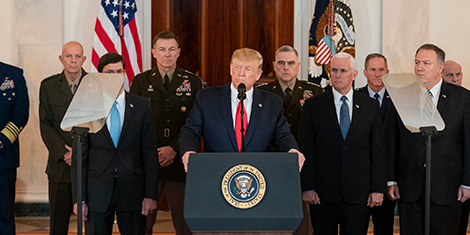
This article was originally published by the ASPI‘s The Strategist on 9 January 2020.
President Donald Trump’s public response to Iranian missile strikes on two US airbases in Iraq suggests that he and Iran’s supreme leader, Ayatollah Ali Khamenei, have reached a mutual ‘no war’ agreement. Barring any miscalculation by either side that triggers military escalation, the confrontation will continue to be played out politically, with the US maintaining its ‘maximum pressure’ campaign that seeks to force regime change through severe economic sanctions. There will be a lot of bruising ahead for Iran, but Trump will not win politically.
The absence of any US casualties or significant equipment damage from the strikes at the Al Asad and Erbil air bases in Iraq yesterday, and Trump’s decision not to retaliate as threatened, suggest the no-war agreement was reached through intensive back-channel negotiations.
By capping military escalation at this point, Trump can still boast that he’s tough and decisive. He can claim Iran that has backed down to US threats, and that his commitment to countering terrorism is well demonstrated by the killing of the commander of the Islamic Revolutionary Guard Corps’ Quds Force. Trump’s branding of Qassem Soleimani as the world’s ‘number one terrorist’ not only ‘justified’ his assassination but also implicitly matches his predecessor Barack Obama’s resolve in killing Osama bin Laden.
Iran’s missile attacks against the two US bases will go some way to necessarily demonstrating Khamenei’s vow of ‘severe revenge’ for Soleimani’s killing. Tehran may be planning a longer-term response that goes further, but not so far that it precipitates a much stronger US military reaction. To achieve this, Iran will need to be able to control the actions of its proxies. That can’t be guaranteed, and Trump has made it clear he will hold Iran accountable for proxy actions.
Who initiated the negotiations is not known, but clearly Iran understood that it couldn’t win an all-out military confrontation with the US. Iran’s assessments of Trump’s possible responses to retaliatory military action by Iran and/or its proxies would have included a controlled, proportional tit-for-tat escalation. Iran also would have planned for a scenario in which Trump ignored proportionality and ordered strikes against Iranian and proxy command-and-control centres, missile and drone facilities, and other military and strategic facilities.
Nuclear facilities would almost certainly have been included in any such strike—especially given Iran’s announcement on 5 January that it is now disregarding all uranium enrichment controls under the nuclear deal. Trump’s morally indefensible threat to destroy Iranian cultural sites, however, was always unlikely to come to pass.
Trump’s frustration and ego suggest that there would have been a higher likelihood of large-scale US strikes if Iran’s action had incurred any American casualties. Trump could have achieved all his targeted outcomes within 24 hours, before conceding to an inevitable urgent UN ceasefire resolution.
Although Iran, as the underdog, could be expected to acquit itself credibly through conventional and asymmetric means, Khamenei could not afford the threat of such carnage to his country or regime. For Iran, softer, largely political, action will remain its preferred option.
Although Trump can boast military superiority, he will not win politically. US influence in the region is diminishing, and while Trump has largely blamed Iran for this, there are other reasons for America’s waning power. For its part, Iran will want to exploit Soleimani’s assassination through political action, including promoting condemnation of Trump and US policies in the UN and other international forums, and at the parliamentary and party levels in individual countries, as well as through non-violent street demonstrations and social media. This is already happening regionally, especially among Shia communities, and in India through demonstrations outside the US embassy in New Delhi.
Iraq will continue to be a major arena for Iran–US confrontation. Its sovereignty was blatantly breached in the attack on Soleimani assassination, which also killed Abu Mahdi al-Muhandis, deputy commander of Iraq’s Popular Mobilisation Forces. The Iraqi parliament has passed a non-binding motion rejecting the presence of US and coalition, including Australian, forces in Iraq. While this does not require the immediate expulsion of these forces, it does impose restrictions on the activities of those forces and anticipates their eventual withdrawal.
Trump threatened to impose severe economic sanctions on Iraq if US forces are expelled. The insensitivity of this will resonate with other countries hosting US forces. Iran will be hoping other countries (especially those in the region) hosting US and allied forces will expel them or impose similar restrictions.
There are clear implications for Australia’s military deployments in Iraq, and for our deployments elsewhere in the Middle East. While it’s unlikely Australia or other US non-regional allies would be deliberately targeted if the situation re-escalates, the possibility of those integrated with US forces becoming unintentional collateral damage cannot be dismissed.
The latest events also send a very timely message to the Australian government about the need to carefully consider its response, consider why and whether the Australian Defence Force should remain in Iraq, and re-evaluate other and future commitments in the region.
About the Author
Ian Dudgeon is a presidential associate of the Australian Institute of International Affairs (ASPI).
For more information on issues and events that shape our world, please visit the CSS website.

